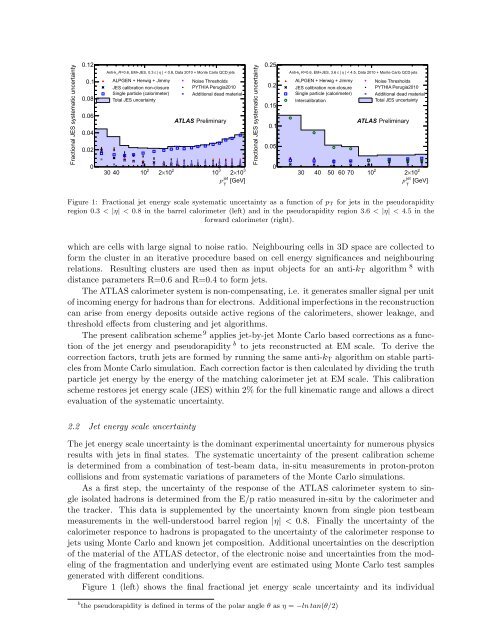2011 QCD and High Energy Interactions - Rencontres de Moriond ...
2011 QCD and High Energy Interactions - Rencontres de Moriond ...
2011 QCD and High Energy Interactions - Rencontres de Moriond ...
Create successful ePaper yourself
Turn your PDF publications into a flip-book with our unique Google optimized e-Paper software.
Fractional JES systematic uncertainty<br />
0.12<br />
0.1<br />
0.08<br />
0.06<br />
0.04<br />
0.02<br />
0<br />
Anti-k R=0.6,<br />
EM+JES, 0.3 ≤ | η | < 0.8, Data 2010 + Monte Carlo <strong>QCD</strong> jets<br />
t<br />
ALPGEN + Herwig + Jimmy Noise Thresholds<br />
JES calibration non-closure PYTHIA Perugia2010<br />
Single particle (calorimeter)<br />
Total JES uncertainty<br />
Additional <strong>de</strong>ad material<br />
30 40<br />
2<br />
10<br />
2<br />
2×<br />
10<br />
ATLAS Preliminary<br />
3<br />
10<br />
p<br />
jet<br />
T<br />
3<br />
2×<br />
10<br />
[GeV]<br />
Fractional JES systematic uncertainty<br />
0.25<br />
0.2<br />
0.15<br />
0.1<br />
0.05<br />
0<br />
Anti-k R=0.6,<br />
EM+JES, 3.6 ≤ | η | < 4.5, Data 2010 + Monte Carlo <strong>QCD</strong> jets<br />
t<br />
ALPGEN + Herwig + Jimmy Noise Thresholds<br />
JES calibration non-closure PYTHIA Perugia2010<br />
Single particle (calorimeter) Additional <strong>de</strong>ad material<br />
Intercalibration<br />
Total JES uncertainty<br />
30 40 50 60 70<br />
ATLAS Preliminary<br />
2<br />
10<br />
2×<br />
10<br />
p [GeV]<br />
Figure 1: Fractional jet energy scale systematic uncertainty as a function of pT for jets in the pseudorapidity<br />
region 0.3 < |η| < 0.8 in the barrel calorimeter (left) <strong>and</strong> in the pseudorapidity region 3.6 < |η| < 4.5 in the<br />
forward calorimeter (right).<br />
which are cells with large signal to noise ratio. Neighbouring cells in 3D space are collected to<br />
form the cluster in an iterative procedure based on cell energy significances <strong>and</strong> neighbouring<br />
relations. Resulting clusters are used then as input objects for an anti-kT algorithm 8 with<br />
distance parameters R=0.6 <strong>and</strong> R=0.4 to form jets.<br />
The ATLAS calorimeter system is non-compensating, i.e. it generates smaller signal per unit<br />
ofincomingenergyforhadronsthanforelectrons. Additionalimperfectionsinthereconstruction<br />
can arise from energy <strong>de</strong>posits outsi<strong>de</strong> active regions of the calorimeters, shower leakage, <strong>and</strong><br />
threshold effects from clustering <strong>and</strong> jet algorithms.<br />
The present calibration scheme 9 applies jet-by-jet Monte Carlo based corrections as a function<br />
of the jet energy <strong>and</strong> pseudorapidity b to jets reconstructed at EM scale. To <strong>de</strong>rive the<br />
correction factors, truth jets are formed by running the same anti-kT algorithm on stable particles<br />
from Monte Carlo simulation. Each correction factor is then calculated by dividing the truth<br />
particle jet energy by the energy of the matching calorimeter jet at EM scale. This calibration<br />
scheme restores jet energy scale (JES) within 2% for the full kinematic range <strong>and</strong> allows a direct<br />
evaluation of the systematic uncertainty.<br />
2.2 Jet energy scale uncertainty<br />
The jet energy scale uncertainty is the dominant experimental uncertainty for numerous physics<br />
results with jets in final states. The systematic uncertainty of the present calibration scheme<br />
is <strong>de</strong>termined from a combination of test-beam data, in-situ measurements in proton-proton<br />
collisions <strong>and</strong> from systematic variations of parameters of the Monte Carlo simulations.<br />
As a first step, the uncertainty of the response of the ATLAS calorimeter system to single<br />
isolated hadrons is <strong>de</strong>termined from the E/p ratio measured in-situ by the calorimeter <strong>and</strong><br />
the tracker. This data is supplemented by the uncertainty known from single pion testbeam<br />
measurements in the well-un<strong>de</strong>rstood barrel region |η| < 0.8. Finally the uncertainty of the<br />
calorimeter responce to hadrons is propagated to the uncertainty of the calorimeter response to<br />
jets using Monte Carlo <strong>and</strong> known jet composition. Additional uncertainties on the <strong>de</strong>scription<br />
of the material of the ATLAS <strong>de</strong>tector, of the electronic noise <strong>and</strong> uncertainties from the mo<strong>de</strong>ling<br />
of the fragmentation <strong>and</strong> un<strong>de</strong>rlying event are estimated using Monte Carlo test samples<br />
generated with different conditions.<br />
Figure 1 (left) shows the final fractional jet energy scale uncertainty <strong>and</strong> its individual<br />
b the pseudorapidity is <strong>de</strong>fined in terms of the polar angle θ as η = −lntan(θ/2)<br />
jet<br />
T<br />
2








![List of participants 27/2/09 [pdf] - Rencontres de Moriond - IN2P3](https://img.yumpu.com/17975746/1/190x135/list-of-participants-27-2-09-pdf-rencontres-de-moriond-in2p3.jpg?quality=85)







